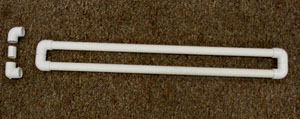
A rectangle of PVC showing an exploded view of the pieces at one end.
Click on the image to enlarge it.
Picket the fence model
Introduction
The classic model of a plastic polarizing filter is the picket fence model. In this exploration we'll send waves on a string through one gap in a picket fence made of PVC to observe polarization.
Material
PVC pipe, 3/4 inch schedule 40, two pieces 30 inches long (750 cm), two pieces each 1.5 inches long (3.7 cm)
Four 90 degree angles for 3/4 inch schedule 40 PVC pipe.
A coiled phone cord sold as "25 feet" length, or 1/4 inch (6 mm) diameter nylon cord 25 feet long.
Assembly
Press together the 90 degree PVC elbows and the pieces of PVC to make a long thin rectangle of PVC pipe.

To Do and Notice
Thread the cord between the rectangle.
Have two people hold the ends of the cord, and a third person hold the rectangle with its long axis vertical.
Have one person shake the cord up and down, parallel to the longest dimension of the rectangle.
Have them shake it a couple of times but do not have them set up a standing wave on the cord.
Notice that the wave passes through the rectangle.

Shake the cord back-and-forth horizontally and notice that it does not pass through the vertical slit of the polarizer.
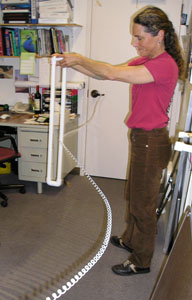
Shake the cord in a plane that is neither horizontal nor vertical, e.g. tilted 45 degrees from the vertical, and notice that only the component of the wave parallel to the long axis of the rectangle passes through the slit.
Shake the cord in a circular motion and notice that only the linear component parallel to the slit gets through.
What's Going On?
A wave in a phone cord models a wave of polarized light.
If you shake the cord up and down this models vertically polarized light.
Shake it side to side to model horizontally polarized light.
Shake it in a circle to model circularly polarized light.
The rectangle of PVC models the action of a polarizer.
A plane polarized wave passes through a slit that is parallel to its direction of polarization.
A plane polarized wave will not pass through a slit oriented perpendicular to its direction of polarization.
Half of a circularly polarized wave will pass through a slit in any orientation.
Only a component of a plane polarized wave will pass through a slit oriented at an angle T relative to the direction of polarization.
Math Root
The amplitude A of the component of a light wave of amplitude 1 that passes through a polarizer tilted at an angle of T degrees with respect to the direction of polarization of the wave is
A = cos T
The intensity, I, of light is proportional to the square of the amplitude, A, of the light wave.
I a A2
The intensity, of this light is I a Cos2T
Going Further
Make two PVC rectangles and thread the cord through both of them. Hold the rectangle a meter or two apart. Notice the waves that pass through the two polarizers as one polarizer is rotated relative to the other.
History
The French scientist Arago noted that light reflecting off glass at an angle had special properties. Further experiments convinced him that these properties came about because light is a transverse wave. He named these properties polarization.
Today is is simple to do an experiment like that done by Arago. Look at light reflecting from a glass window at a 45 degree angle (approximately). Look at the reflection again through polarized sunglasses. Standing normally you will be able to see the reflection, rotate your head 90 degrees so your eyes are on a vertical line and the reflection almost disappears. (Photographers use polarizing filters to control reflections.) It was harder for Arago to do this experiment since he didn't have polarized sunglasses.
Edwin Land, who founded the Polaroid corporation, embedded herapathite crystals in plastic sheet then stretched the plastic sheet to align the crystals and make a sheet polarizer. Later he discovered that certain plastics exposed to iodine would act as polarizers. The polarizing films you see today are almost always made by this process of iodizing stretched plastic.
According to an early 20'th century model of light, light is an electromagnetic wave. The electromagnetic wave is made of an electric field wave oscillating perpendicular to a magnetic field wave. The direction of oscillation of the electric field wave is the direction of polarization of the light.
When light hits an electron the electron
accelerates.
When light is linearly polarized in the vertical direction the
electron accelerates in the vertical direction, i.e. up and down.
Horizontally polarized light accelerates the electron right and
left.
Polarized light can also accelerate the electron in a clockwise circle, this is right circularly polarized light. There is also left circularly polarized light that accelerates the electron in a counterclockwise circle.
Each photon has a polarization. A collection of photons with different polarizations makes unpolarized light.
When unpolarized light made of photons with all directions and types of polarization strikes a linear polarizing sheet only one direction of linearly polarized light passes through the sheet.
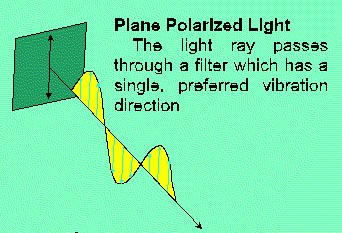
After passing through a linear polarizer the direction of
oscillation of the electric field of light is linear.
You can see polarized light effects using a pair of polarized sunglasses.
Polarized sunglasses snack
Wire Grid Polarizer
Edmund scientific sells a wire grid linear light polarizer.
http://www.edmundoptics.com/onlinecatalog/displayproduct.cfm?productID=2294&search=1
These polarizers consist of a thin layer of aluminum MicroWire sandwiched between two glass windows. Light polarized parallel to the wires is reflected, light polarized perpendicular to the wires is transmitted. The last statement is correct. It disagrees with the simple picket fence model of polarizers. In which waves polarized parallel to the slits in the picket fence are transmitted, while perpendicular polarizations are reflected or absorbed.
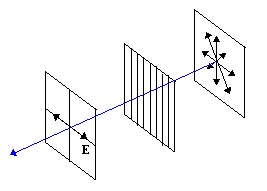
When randomly polarized light from the right passes through an
array of microwires it becomes polarized perpendicular to the
microwires.
This is the opposite to what is predicted by the picket fence model of polarized light, this classic model is shown here in an illustration by Paul Hewitt.
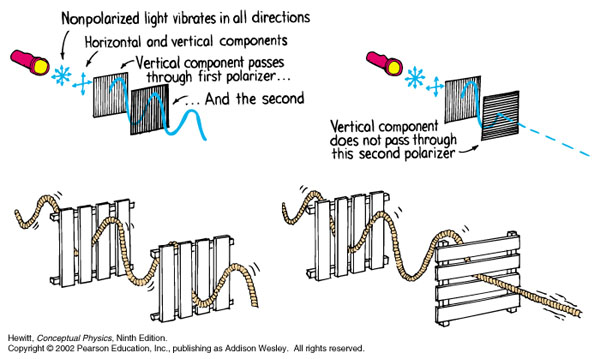
The picket fence model of polarizing light does not work for the most common plastic polarizer invented by Edwin Land and used in polarized sunglasses. In these plastic sheet polarizers the random chain polymers are stretched in one direction becoming long chains parallel to the direction of stretch. These polymers are coated with iodine. Electrons from the iodine can move with electrical resistance along the stretched polymers, they cannot move perpendicular to the polymers. When an electric field wave from light polarized parallel to the stretched polymers strikes the polarizer it pushes electrons along the direction of the stretched polymers. Electrons move in this direction removing energy from the light turning the lights into heat. When light polarized perpendicular to the stretch of the polymer strikes the polarizer electrons do not move and so the light passes through the polarizer without absorption.

A photon model
A model of a photon is that it is a wave of probability density, photons have a wavelength, for example visible light has a wavelength near 500 nm. That is 5000 times bigger than an atom, or 500 times smaller than a human hair diameter. The wavelength which is related to the frequency determines the color a person will see when the photon is detected by a human eye. A photon has a diameter which is infinite, but most of the photon is within a diameter equal to a single wavelength. A photon from a fluorescent light is about 3 meters long.
The molecules in a polarizing sheet are smaller than 10 nm in diameter and are spaced closer than 10 nm apart. So a photon is 50 times larger in diameter than the molecules or their spacing.
Also the polarizing sheet is many thousands of molecules thick so that to the photon the polarizing sheet looks like a woodland full of trees, there are no clear lines of sight through the trees.
A website about polarized light.
http://www.polarization.com/index-net/index.html
|
Scientific Explorations with Paul Doherty |
|
18 March 20005 |